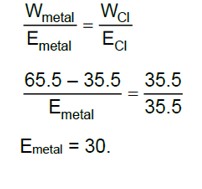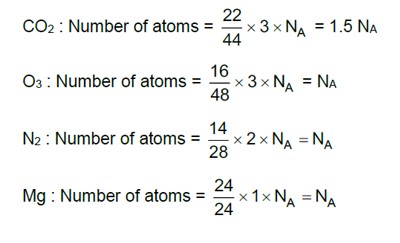Which of the following statements indicates that law of multiple proportion is being followed.
(i) Sample of carbon dioxide taken from any source will always have carbon and oxygen in the ratio 1:2.
(ii) Carbon forms two oxides namely CO2 and CO, where masses of oxygen which combine with fixed mass of carbon are in the simple ratio 2:1.
(iii) When magnesium burns in oxygen, the amount of magnesium taken for the reaction is equal to the amount of magnesium in magnesium oxide formed.
(iv) At constant temperature and pressure 200 mL of hydrogen will combine with 100 mL oxygen to produce 200 mL of water vapour.
Which of the following statements indicates that law of multiple proportion is being followed.
(i) Sample of carbon dioxide taken from any source will always have carbon and oxygen in the ratio 1:2.
(ii) Carbon forms two oxides namely CO2 and CO, where masses of oxygen which combine with fixed mass of carbon are in the simple ratio 2:1.
(iii) When magnesium burns in oxygen, the amount of magnesium taken for the reaction is equal to the amount of magnesium in magnesium oxide formed.
(iv) At constant temperature and pressure 200 mL of hydrogen will combine with 100 mL oxygen to produce 200 mL of water vapour.
-
1 Answer
-
This is a Multiple Choice Questions as classified in NCERT Exemplar
Option (B)
Law of multiple proportion: According to the law of multiple proportion, whe form two or more than two chemical compounds, the ratio between different elements combining with a fixed mass of the other is always in the ratio of tin Compounds of carbon and oxygen:
Carbon and oxygen react to form two different compounds CO and CO2. In Carbon react with 16 parts by mass of oxygen.
In CO2 ,12 parts by mass of Carbon react with 32 parts by mass of oxygen. If the mass of Carbon is fixed at 12 parts of mass then the ratio in the masses with the fixed mass of
...more
Similar Questions for you
In the medical entrance test NEET, there can be 1 to 3 questions from this chapter. Some year, the Chemistry section of NEET has only one question from this chapter and in some other years, there can be 3 questions.
The following are the key concepts of this chapter: Compound, Elements, Rules, Law of conservation of mass, Addition and Subtraction, Atomic Mass, Law of multiple proportions, and Molecular Mass.
As the name suggests, the first chapter of the NCERT Class 11 Chemistry introduces various basic concepts of chemistry, such as the definition and importance of chemistry, atomic matter and molecular masses, the mole concept, laws of chemical combination, empirical, stoichiometry, and molecular formulas. It also includes the concepts of molarity and molality.
Taking an Exam? Selecting a College?
Get authentic answers from experts, students and alumni that you won't find anywhere else
Sign Up on ShikshaOn Shiksha, get access to
- 65k Colleges
- 1.2k Exams
- 679k Reviews
- 1800k Answers


